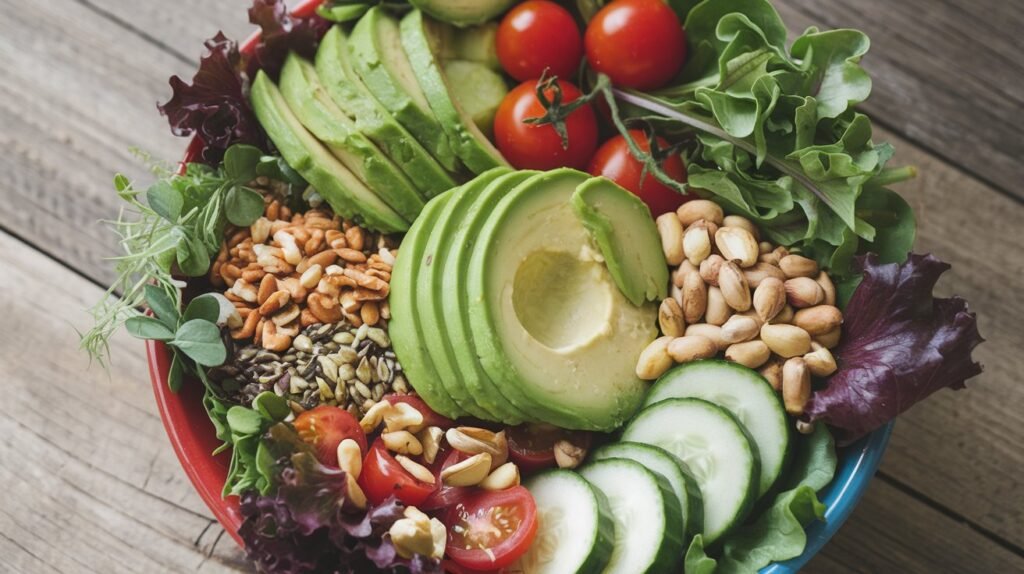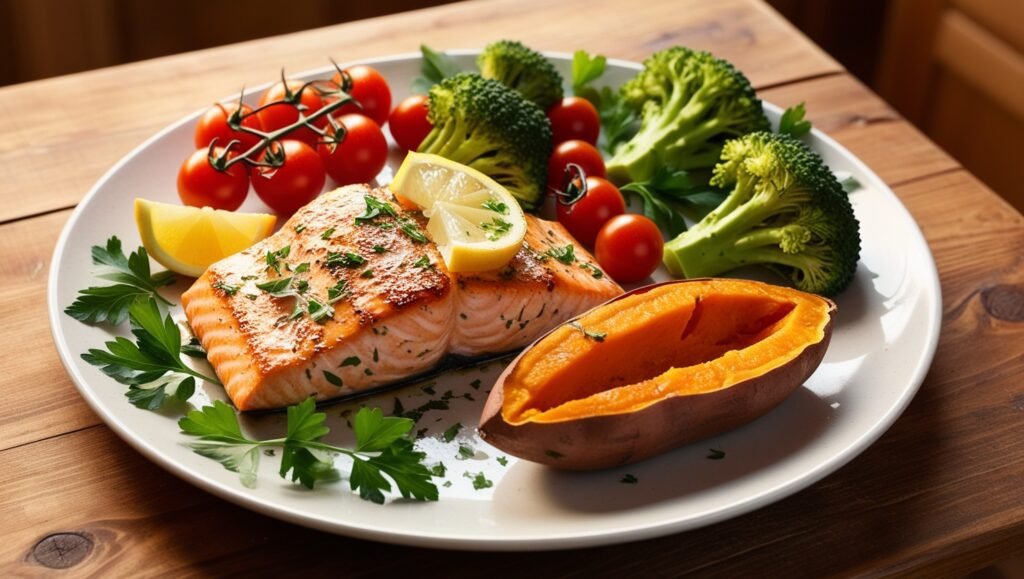Introduction
The Paleo diet, often called the “caveman diet,” emphasizes whole, unprocessed foods that humans would have eaten during the Paleolithic era. Proponents claim it promotes weight loss, reduces inflammation, and improves overall health by focusing on foods that align with our genetic makeup. In this article, we’ll delve deep into the science, benefits, and practical applications of the Paleo diet. We’ll also look at foods allowed and restricted, along with some sample meal plans to help you get started.
Table of Contents
What is the Paleo Diet?

The Paleo diet is based on the idea that the human body is genetically suited to eat like our ancestors. It emphasizes whole foods that are free from modern processing. The core belief is that by following this diet, individuals can better align with their evolutionary biology and thus improve health and fitness.
| Key Features of the Paleo Diet: Emphasizes whole, unprocessed foods like meats, fish, vegetables, and fruits. Excludes grains, legumes, dairy, and refined sugars which are considered “modern” foods. Promotes healthy fats such as those from fish, avocados, and nuts. High in protein and low in carbohydrates, which some believe can help regulate blood sugar levels and reduce chronic disease risk. |
The Benefits of the Paleo Diet
1. Weight Loss
Many people follow the Paleo diet to lose weight. The high-protein content helps to keep hunger at bay, while the exclusion of processed and sugary foods minimizes unnecessary calorie intake. Studies have shown that low-carb, high-protein diets like Paleo may be more effective than traditional calorie-restricted diets for weight loss.
- Statistic: A 2014 study published in Diabetes, Metabolic Syndrome and Obesity found that individuals following the Paleo diet lost 3.52 kg more weight on average than those on a regular diet over a period of six months.
2. Improved Blood Sugar Control
The elimination of refined carbohydrates and processed foods can lead to better insulin sensitivity, making the Paleo diet a good option for those with type 2 diabetes or insulin resistance.
3. Reduced Inflammation
Inflammation is linked to many chronic diseases, including heart disease and arthritis. By avoiding processed foods, sugar, and refined oils, the Paleo diet can help reduce inflammation in the body.
4. Enhanced Energy Levels
Many Paleo followers report improved energy levels due to the balanced intake of healthy fats, proteins, and vegetables that support stable blood sugar.
5. Improved Gut Health
A diet rich in vegetables, fruits, and natural fibers promotes better digestion and gut health. The avoidance of gluten and other inflammatory foods also reduces bloating and digestive discomfort.
Foods Allowed on the Paleo Diet

One of the cornerstones of the Paleo diet is the emphasis on whole foods. Below is a list of foods that are typically allowed and encouraged:
| Food Category | Examples |
|---|---|
| Meat & Poultry | Grass-fed beef, chicken, turkey, lamb |
| Fish & Seafood | Salmon, mackerel, sardines, shellfish |
| Vegetables | Leafy greens, broccoli, cauliflower, carrots, peppers |
| Fruits | Apples, berries, citrus fruits, bananas |
| Nuts & Seeds | Almonds, walnuts, flaxseeds, chia seeds |
| Healthy Fats | Avocados, olive oil, coconut oil, nut butters |
| Eggs | Free-range or pasture-raised eggs |
Foods to Avoid
The following foods are typically avoided on the Paleo diet due to their processing or the fact that they were not available in Paleolithic times:
| Food Category | Examples |
|---|---|
| Grains | Wheat, rice, oats, barley, quinoa |
| Legumes | Beans, lentils, peanuts, chickpeas |
| Dairy | Milk, cheese, yogurt, butter |
| Processed Foods | Sugary snacks, packaged foods, refined oils |
| Refined Sugar | Candy, cakes, soft drinks, and other sugary foods |
| Artificial Sweeteners | Aspartame, sucralose, saccharin |
Scientific Backing of the Paleo Diet
Several studies have explored the potential benefits of the Paleo diet for weight loss, metabolic health, and inflammation. Here’s a quick summary of some relevant research:
- Weight Loss: A 2008 study published in the European Journal of Clinical Nutrition showed that subjects following a Paleo diet lost more fat compared to those on a Mediterranean diet.
- Cardiovascular Health: A 2013 study in Diabetes, Metabolic Syndrome and Obesity found that participants who followed a Paleo diet experienced better cholesterol levels and lower blood pressure compared to a typical diet.
- Gut Health: A study from World Journal of Gastroenterology (2015) showed that the Paleo diet may improve gut health by reducing gut permeability and improving the balance of gut bacteria.
Paleo Diet vs. Other Diets
Paleo vs. Keto Diet
While both the Paleo and ketogenic diets emphasize low-carbohydrate intake, the keto diet focuses more on achieving a state of ketosis by consuming a high amount of fat. In contrast, Paleo is more focused on whole foods and avoids processed items rather than macronutrient manipulation.
Paleo Diet vs. Mediterranean Diet
The Mediterranean diet allows whole grains, legumes, and dairy, which are off-limits in the Paleo diet. Both diets encourage the consumption of fruits, vegetables, and healthy fats, but Paleo excludes foods that would not have been available in ancient times.
| Diet | Primary Focus | Allowed Foods | Restricted Foods |
|---|---|---|---|
| Paleo | Whole, unprocessed foods | Meat, fish, fruits, vegetables, nuts, healthy fats | Grains, legumes, dairy, processed foods |
| Keto | High fat, low carbohydrate | High-fat foods, moderate protein, minimal carbs | Most fruits, grains, legumes, starchy vegetables |
| Mediterranean diet | Balance of healthy fats and whole foods | Whole grains, fruits, vegetables, fish, olive oil | Processed foods, excessive sugar, red meats |
Sample Paleo Meal Plan

Here’s a sample 3-day meal plan to help you get started:
| Day | Meal | Food |
|---|---|---|
| Day 1 | Breakfast | Scrambled eggs with spinach and avocado |
| Lunch | Grilled chicken salad with mixed greens, olive oil, and nuts | |
| Dinner | Baked salmon with roasted broccoli and sweet potatoes | |
| Day 2 | Breakfast | Smoothie with coconut milk, berries, and chia seeds |
| Lunch | Lettuce wrap with turkey, avocado, and tomatoes | |
| Dinner | Grass-fed steak with sautéed vegetables | |
| Day 3 | Breakfast | Omelet with mushrooms, bell peppers, and onions |
| Lunch | Tuna salad with cucumber, olives, and olive oil | |
| Dinner | Grilled shrimp with cauliflower rice and roasted vegetables |
Is the Paleo Diet Right for You?
This diet may be a great choice for those who are looking to eliminate processed foods, lose weight, and improve overall health. However, it may not suit everyone, especially those who rely on grains, legumes, or dairy for their dietary needs. As with any diet, it’s essential to consider your individual health needs and consult with a healthcare professional before making significant dietary changes.
Potential Drawbacks:
- Restrictive: The elimination of grains, legumes, and dairy can make the Paleo diet feel restrictive and hard to maintain.
- Nutrient Deficiency: Some people may struggle to get enough calcium, fiber, and other nutrients due to the exclusion of certain food groups.
Conclusion
The Paleo diet offers a natural, whole-food approach to eating that many find beneficial for weight loss, improved energy, and better health. By focusing on foods that our ancestors ate, it eliminates many processed and inflammatory foods prevalent in modern diets. While it may not suit everyone, those who thrive on high-protein, low-carb diets may find it to be a powerful tool for achieving their health and fitness goals.
References
- Lindeberg S, et al. (2008). A Palaeolithic diet improves glucose tolerance more than a Mediterranean-like diet in individuals with ischaemic heart disease. European Journal of Clinical Nutrition, 62(5), 781-788.
- Otten J, et al. (2014). Paleolithic Diet and Its Effects on Weight Loss, Inflammation, and Insulin Sensitivity. Diabetes, Metabolic Syndrome and Obesity.
- Whalen KA, et al. (2016). Dietary patterns and risk of colon cancer. World Journal of Gastroenterology.




